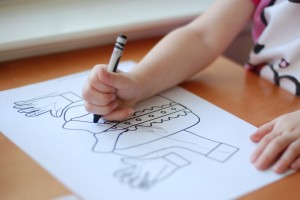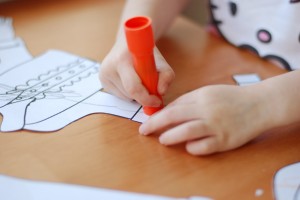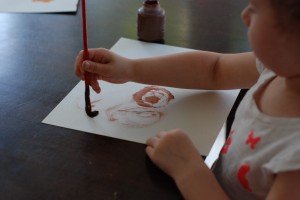 I LOVE arts and crafts. I love drawing, painting, coloring, cutting, gluing, using clay, paper, paints, glitter, craft sticks, and other arts and crafts materials. Have you ever noticed that arts and crafts activities are a staple part of the curriculum in early childhood education? I challenge you to find a preschool that doesn’t incorporate arts and crafts in their lessons. Not only are arts and crafts activities vital for the development of fine motor skills and visual processing skills, but they also are an amazing way to stimulate and expand receptive and expressive language skills! I do crafts all the time with my daughter (and have blogged about a few of them here) and use crafts in my therapy sessions often.
I LOVE arts and crafts. I love drawing, painting, coloring, cutting, gluing, using clay, paper, paints, glitter, craft sticks, and other arts and crafts materials. Have you ever noticed that arts and crafts activities are a staple part of the curriculum in early childhood education? I challenge you to find a preschool that doesn’t incorporate arts and crafts in their lessons. Not only are arts and crafts activities vital for the development of fine motor skills and visual processing skills, but they also are an amazing way to stimulate and expand receptive and expressive language skills! I do crafts all the time with my daughter (and have blogged about a few of them here) and use crafts in my therapy sessions often.
Why crafts are great for language development: Crafts are amazing for language development because they require being able to understand basic concepts, follow directions, and answering and asking “wh” questions (among other skills). Therefore, crafts can be used by parents, speech pathologists, and early childhood educators to teach/target/practice the following:
- Vocabulary of basic concepts (spacial, temporal, quantity, and quality)
- Vocabulary of nouns
- Vocabulary of verbs
- Following 1,2,3 plus step directives
- Answering “wh” questions
- Asking “wh” questions
- Giving 1,2,3 plus step directives
- Social/pragmatic skills like requesting, protesting, informing, eye contact, turn taking, etc.
- Articulation skills
- Fluency and Voice skills
How to stimulate and expand language skills during crafts:

- Use the strategy of self talk as you and your child (or student) are doing the craft. This is when you (the adult) talks about what you are seeing, hearing or doing. For example, “I am gluing the red paper to the yellow paper” or “I am cutting the paper”.
- Use the strategy of parallel talk as you and your child (or student) are doing the craft. This is when you are talking about what the child is seeing, hearing, or doing. For example, “You are cutting the paper” or “You are gluing the circle on the paper.”
- Use the strategy of descriptive talk to talk all about the items you are using in the craft. Descriptive talk is when you describe the objects/items you see or are manipulating. For example “The glue is sticky” or “The paint is wet.”

- Use the strategy expansions of to help expand your child’s utterances. Expansions are when you take the words your child says about what they see and do and repeat them with missing words/grammar. Another way to look at it, is repeating back the “child-like†sentences back to your child using more “adult†language. For example, if your child says “Me paint” you can say “Yes you are paining!” or if your child says “Play-dough blue” you can say “Yes that play-dough is blue!”
- Use the strategy of extensions to help extend your child’s utterances and introduce them to new vocabulary and concepts. Extensions are similar to expansions, but one more step up. In extensions you not only are repeating and expanding your child’s language, but you will also be adding or extending new information. For example, if your child said “Paint yellow” you could say “Yes, that paint is yellow! The paint is wet.”
- Be sure to slow down, emphasize and repeat new vocabulary words. Repetition is the key to learning new words!
- Model, Model, Model! Model good speech and language skills during your crafts. Model the language you want your child to use.
- HAVE FUN! This is really the most important part. Make sure not to structure your art time SO much for language learning that the crafts are no longer fun for you and your child! Make sure to balance the learning and the play. 🙂
Cheers!
I love art and craft too and would also love it if you linked some of your excellent posts at the Today at Play year long Link Up.
Georgie, thanks so much for stopping by, I will for sure link up with you!
I am having difficulty signing up for your newsletter.